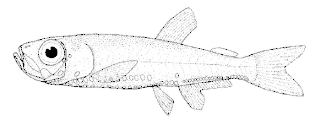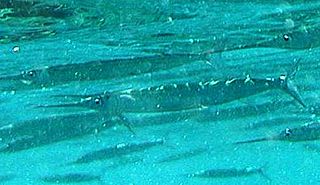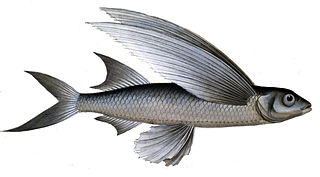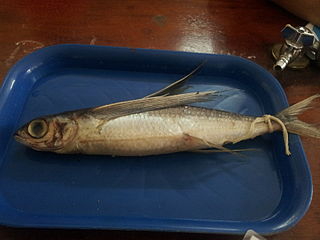
Maurolicus is an oceanic ray-finned fish genus which belongs in the marine hatchetfish family Sternoptychidae. They are commonly known as pearlsides, but the brilliant pearlside is the related Argyripnus iridescens. Occasionally, "bristle-mouth fishes" is used as a common name, but that usually refers to the genus Argyripnus or the family Gonostomatidae.

Hemiramphus is a genus of schooling marine fish commonly called halfbeaks, garfish, or ballyhoos, and are members of the family Hemiramphidae. They inhabit the surface of warm temperate and tropical sea, and feed on algae, plankton, and smaller fish. Hemiramphus species are edible but are more important as food fish for larger predatory species including dolphinfish and billfish.

Exocoetus is a genus of flying fishes. It is a bony fish. The body is covered with cycloid scales. The mouth is wide, and the jaws bear teeth. It is a marine fish. The tail has hypobatic fins as the ventral lobe.

Hirundichthys is a genus of flying fish. They have elongated, moderately thick, ventrally flattened bodies. The pectoral branch of the lateral line is absent. The upper jaw is not protrusible. The dorsal fin has fewer or equal rays than the anal fin; the dorsal fin is low, with the anterior rays the longest, the pectoral fins are strikingly long, reaching to or almost to caudal fin base; pelvic fins are long, reaching beyond the anal fin origin, and their insertion is closer to the anal fin origin than to the pectoral fin insertion.

Cypselurus is a genus of flying fish in the family Exocoetidae.

Cheilopogon is a genus of flyingfishes.

Sardinella is a genus of fish in the family Clupeidae found in the Atlantic, Indian and Pacific Ocean. They are abundant in warmer waters of the tropical and subtropical oceans. Adults are generally coastal, schooling, marine fish but juveniles are often found in lagoons and estuaries. These species are distinguished by their ranges and by specific body features, but they are often confused with one another. Fish of the genus have seven to 14 striped markings along the scales of the top of the head. The paddle-shaped supramaxilla bones are characteristic; they separate Sardinella from other genera and their shapes help distinguish species. They have paired predorsal scales and enlarged fin rays.

Mormyrus is a genus of fish in the family Mormyridae.

The mirrorwing flyingfish is a flying fish of the family Exocoetidae. It was first described by the French zoologist, Achille Valenciennes in a 22-volume work titled Histoire naturelle des poissons, which was a collaboration with Georges Cuvier.

The Atlantic flyingfish is a flying fish in the family Exocoetidae. It was first described by the French zoologist, Achille Valenciennes in a 22-volume work entitled Histoire naturelle des poissons, which was a collaboration with fellow zoologist Georges Cuvier.

Hyporhamphus is a genus of halfbeaks. The species in this genus are distributed throughout the warmer seas of the world, most species being Indo-Pacific and there are some freshwater species.

Ilisha is a genus of ray-finned fishes in the family Pristigasteridae. The genus contains 16 species. It is similar to Pellona but lacks a toothed hypo-maxilla. The genus has a worldwide distribution in tropical and subtropical coastal waters and estuaries. Some species also enter rivers, and I. amazonica and I. novacula are largely–if not entirely–restricted to tropical rivers.

Hoplias is a genus of fish in the family Erythrinidae found in Central and South America.
Glossanodon is a genus of fishes in the family Argentinidae.

Fodiator is a genus of flying fishes. It is the only genus in the subfamily Fodiatorinae.

Parexocoetus is a genus of flying fishes. They are found in the tropical and subtropical western Atlantic and Indo-Pacific Oceans. It is the only genus in the subfamily Parexocoetinae which is unique among the flying fishes in having a jaw which is very protrusible and having a joint situated between the cranium and the shoulder girdle which allows the head to be more maneuverable than in other lineages of this family.
Rhynchorhamphus is a genus of halfbeaks.

Cheilopogon nigricans, the blacksail flyingfish, also known as African flyingfish, or leaping flyingfish, is a flying fish in the family Exocoetidae. It is an oceanodromous, plankton-eating marine fish which has commercial value.

Hirundichthys rondeletii, the black wing flyingfish, is a species of flying fish from the family Exocoetidae which is found throughout the tropical and subtropical waters of the Atlantic, Pacific and Indian Oceans.
Exocoetus peruvianus, commonly known as the Peruvian flyingfish, is a species of ray-finned fish endemic to the tropical southeast Pacific Ocean in the waters off Peru and Ecuador.
















